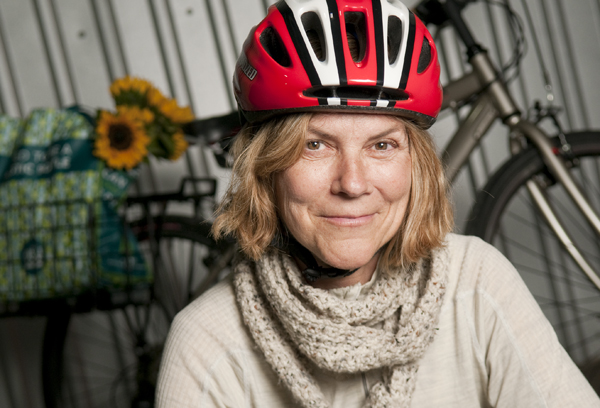Bike coordinator to faculty and staff: be a role model; wear a helmet
There are thousands of bikes rolling around the Stanford campus – as any terrified pedestrian can attest – but not all belong to students. Faculty and staff are bike riders, too – and subject to the same concerns and challenges as students.
Bike Coordinator Ariadne Scott rejoined Stanford in 2008 after leaving for five years to work for a bike manufacturer. She encourages faculty and staff to wear helmets, model good bike behavior, properly secure bikes and consider commuting to work by bike.
Q. Are faculty and staff better about wearing helmets than our students are?
A. We don't have statistics, but informal surveys suggest that faculty and staff do wear helmets more than students. That's a good thing because bike helmets reduce the risk of brain injuries by about 85 percent.
People who attend our bike safety and bike safety citation diversion classes have shared some powerful stories about surviving crashes because they were wearing helmets, including Randy Livingston, vice president for business affairs and CFO. David Spain, who is chief of trauma at Stanford Hospital, has talked to some of the classes about the importance of wearing a helmet. As he says, broken bones can be repaired, but head injuries are not easily fixed.
Q. Are we any better at stopping at stop signs?
A. Well, let's just say that a lot of the bike citations issued on campus last year were for not stopping at stop signs. Faculty and staff – as well as students – need to remember that they are "driving" their bike. California Vehicle Code says that bicyclists have the same rights but are also subject to the same responsibilities of the vehicle code as the driver of a vehicle. So, no running stop signs, riding too fast, riding on the wrong side of the road, wearing headphones in both ears, riding at night without a light, not maintaining your bike and so on. It's dangerous, and you can get cited. I hope faculty and staff will model good behavior for students, especially by wearing helmets.
Q. You've set up some trial bike maintenance sites on campus. Where are they and what are they about?
A. We've installed a pilot bike repair stand at Galvez Mall and Escondido Road, near the Galvez Modules. The station has tools that are securely fastened to a rack. It's vital that everyone maintains a safe bike, so we are trying to make it convenient to access tools for minor repairs and to pump up tires. Another station will be installed this quarter near the Medical School.
Q. Bike theft is a challenge for everyone. What can we do to avoid having bikes stolen?
A. First, use a U-shaped lock, not a cable lock that is easily cut. Second, always lock the bike to a rack, and make sure you lock the wheel and the frame to the rack. Bikes that are kickstand parked can be picked up and taken away. Finally, register your bike. It's the law in Santa Clara County, but Public Safety also says that bikes that are registered are less likely to be stolen. It's only $3.50 and is valid for up to three years. And, if the bike is registered, it can be returned if it is stolen and found.
If you ride an expensive bike, you might want to rent a bike locker. There are multiple locations on campus. For campus use, a clunker is probably best because it's not attractive to thieves.
You can register your bike weekdays at Parking and Transportation Services at 340 Bonair Siding or you can go to White Plaza most Fridays from 11 a.m. to 2 p.m.
Q. What services do you offer to those who commute by bike?
A. This spring, we will launch a commute-by-bike promotion with a safety focus to get more people riding to work, especially those within a 5-mile commuting distance.
Also, people who attend our free bike safety classes can get a coupon to purchase a $40 helmet for only $10. Or you can go to the Campus Bike Shop, where we have a program under which you can get a helmet at a 50 percent discount for only $20. We also will help anyone who wants to consider commuting by bike by creating a safe route or linking him or her up with a bike buddy. Just send an email to bike-information@stanford.edu.


Share This Story